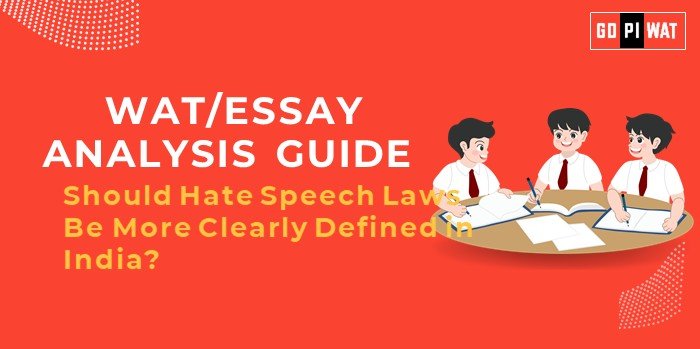📋 WAT/Essay Analysis Guide: Should Hate Speech Laws Be More Clearly Defined in India?
🌐 Understanding the Importance
India’s democratic fabric depends on free speech while maintaining harmony. Clearly defined laws can ensure these principles are upheld without overlap or misuse.
🕒 Effective Planning and Writing
- Time Allocation:
- Planning: 5 minutes
- Writing: 20 minutes
- Review: 5 minutes
- Word Count Distribution:
- Introduction: 70 words
- Body: 375 words
- Conclusion: 55 words
✨ Introduction Techniques
- Contrast Approach: “While free speech is a constitutional right, its misuse to spread hate disrupts democracy.”
- Timeline Approach: “From colonial sedition laws to digital hate speech, India’s legal system grapples with evolving challenges.”
📊 Structuring the Essay Body
🏆 Achievements:
- Accountability: Laws like IPC Sections 153A, 295A ensure some level of accountability.
- Digital Awareness: Recognition of digital hate speech as a critical issue.
⚠️ Challenges with Comparative Analysis:
- India: Vague definitions and digital gaps.
- Germany: Clear definitions with proactive enforcement.
📈 Future Outlook:
- Propose precise definitions.
- Leverage tech-enabled monitoring.
- Incorporate global best practices for a balanced framework.
📌 Concluding Effectively
- Balanced Perspective: “While stronger hate speech laws are needed, their enforcement must align with democratic values.”
- Global Comparison: “Learning from nations like Germany can shape India’s balanced approach.”
📚 Analyzing Successes and Shortcomings
- Key Achievements: Awareness of hate speech and some enforcement success.
- Ongoing Challenges: Ambiguity, digital platforms, and misuse of laws.
- Global Context: Germany, UK, and US offer scalable examples.
🌟 Recommendations for Sustainable Progress
- Define hate speech with constitutional clarity.
- Develop tech-driven, unbiased enforcement mechanisms.
- Conduct awareness campaigns to educate citizens on hate speech and its impact.
📝 Sample Short Essays
Balanced Perspective:
“Hate speech laws need precision to balance free speech and societal peace. Definitions must protect rights without encouraging censorship.”
Solution-Oriented:
“The answer lies in adopting technology to monitor hate speech while safeguarding freedom of expression.”
Global Comparison:
“India’s journey to defining hate speech can draw lessons from Germany’s NetzDG for a balanced, scalable framework.”
This framework ensures clarity, structure, and actionable insights for B-school discussions and essays.


